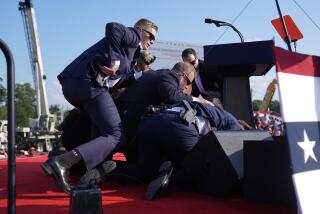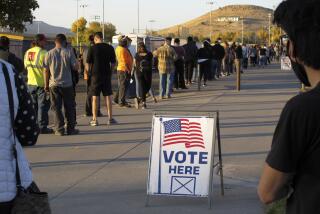RUFFLES AND FLOURISHES
- Share via
1789: First Congress sets president’s salary at $25,000 a year. President George Washington declines personal compensation guaranteed by Constitution. Travels in elegant coach drawn by six matched horses or rides white stallion.
1797: John Adams is the first president to live in the executive mansion, built starting in 1792. The house has no indoor plumbing. Abigail Adams hangs the family wash in unfinished East Room.
1809: Presidents pay for food and drink at state dinners. Thomas Jefferson leaves office $20,000 in debt, having spent more than $10,000 on wine alone over the course of eight years.
1814: Executive mansion burned by the British during the War of 1812. Rebuilt and painted, it is dubbed the White House.
1840s: Congress designates funds for White House staff: A doorman, two gardeners and a guard.
1853: President Franklin Pierce moves into White House. Mansion is so sparsely furnished he sleeps on mattress on floor. Congress allocates $25,000 for improvements; Pierce installs the White House’s first furnace.
1873: Congress raises the chief executive’s salary to $50,000, doubling President Ulysses S. Grant’s pay for his second term.
1906: Theodore Roosevelt becomes first to receive an annual travel allowance. The sum: $25,000.
1909: Another pay increase, to $75,000, is effective with William Howard Taft’s inauguration.
1942: Work begins on Shangri-La, President Franklin D. Roosevelt’s weekend retreat in Maryland, renamed Camp David by President Dwight D. Eisenhower.
1949: Congress approves a $50,000 tax-free expense account and increases presidential salary to $100,000, effective with President Harry S. Truman’s second term.
1958: With Truman facing financial ruin a few years after retirement, Congress initiates first retirement benefits for former presidents, 149 years after Jefferson left office almost destitute.
1961: John F. Kennedy, wary of criticism over his personal wealth, becomes the second U.S. president to decline his salary, returning it to the Treasury.
1969: Presidential compensation amended to $200,000 salary, $50,000 expense account and tax-free $100,000 travel and $12,000 (currently $20,000) entertainment allowances.
1973: Congressional committee finds questionable expenditures in the renovation of Richard M. Nixon’s homes in Key Biscayne, Fla., and San Clemente. Part of the $10 million in federal funds was spent legitimately for increased security, office space and helicopter pads. But other costs paid for by government include $18,494 for a heating system, $621 for an ice-cube maker, $4,981 for a gazebo and $2,329 for a flagpole.
1977: President Jimmy Carter calls for reduction in executive branch perks. Federal officials are instructed to take commercial airline flights in economy class; Carter reduces the motor pool by 40%, has 300 TV sets and 200 radios removed from the White House and the Executive Office Building, sells two presidential yachts and pointedly carries his own bags.
1981: President Ronald Reagan and Nancy Reagan reinstate much of the pomp eschewed by Carter. Marine Band plays “Hail to the Chief” at social events; senior staff is authorized to travel by limousine on business. Izod shirts emblazoned with “White House Tennis Court” are dispensed to players. The Reagans raise more than $1 million in private donations to pay for renovations to the family rooms at the White House.
1984: The Reagans throw a Thanksgiving dinner party for 600 Chinese and American guests in Beijing. The State Department foots the bill. Forty frozen turkeys are flown in from California, canned cranberries from Hong Kong. Three types of California wine are served, along with 440 pounds of prawns, scallops and turbot for the seafood mousses appetizer, 176 pounds of beef used in consomme, 132 pounds of hearts of palm for salads. Seventy-six chefs and a staff 120.
1989: President George Bush inaugurates new 40-foot horseshoe pit on the South Lawn of the White House.
1990: New Air Force One commissioned under Reagan flies its first presidential mission, carrying Bush. Total bill for plane and an identical backup: $250 million. The plane’s doorway is wide enough to accommodate a coffin, should it be necessary.
1993: To keep President Bill Clinton from tying up traffic with his morning jogs, a $30,000 jogging track, financed with private donations, is built on the White House South Lawn. Then-Senate Minority Leader Bob Dole and other Republicans chip in $250 toward the cost.
1994: Clinton, a moviegoer “almost to the point of compulsion,” invites colleagues, actors and directors to view first-run movies with him in the White House movie theater, built by FDR in the 1940s. The Motion Picture Assn. of America provides the films. “Independence Day,” which depicts the White House blasted to bits by galactic invaders, is said to be a favorite of the president.
Presidential timeline source: Congressional Quarterly
More to Read
Sign up for The Wild
We’ll help you find the best places to hike, bike and run, as well as the perfect silent spots for meditation and yoga.
You may occasionally receive promotional content from the Los Angeles Times.






